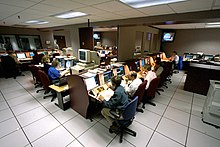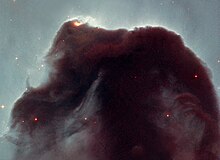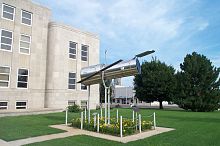Hubble data
Transmission to Earth
Hubble data was initially stored on the spacecraft. When launched, the storage facilities were old-fashioned reel-to-reel tape recorders, but these were replaced by solid state data storage facilities during servicing missions 2 and 3A. Approximately twice daily, the Hubble Space Telescope radios data to a satellite in the geosynchronous Tracking and Data Relay Satellite System (TDRSS).[113] The TDRSS then downlinks the science data to one of two 60-foot (18-meter) diameter high gain microwave antennas located at the White Sands Test Facility inWhite Sands, New Mexico.[113] From there they are sent to the Goddard Space Flight Center and finally to the Space Telescope Science Institute for archiving.[114]
These data are then transmitted to the Space Telescope Operations Control Center (STOCC)located in Greenbelt, Maryland.[113]
Archives
All Hubble data is eventually made available via the archives at STScI,[115] CADC[116] and ESO.[117] Data is usually proprietary—available only to the principal investigator (PI) and astronomers designated by the PI—for one year after being taken. The PI can apply to the director of the STScI to extend or reduce the proprietary period in some circumstances.[118]
Observations made on Director's Discretionary Time are exempt from the proprietary period, and are released to the public immediately. Calibration data such as flat fields and dark frames are also publicly available straight away. All data in the archive is in the FITS format, which is suitable for astronomical analysis but not for public use.[119] The Hubble Heritage Project processes and releases to the public a small selection of the most striking images in JPEG and TIFF formats.[120]
Pipeline reduction
Astronomical data taken with CCDs must undergo several calibration steps before they are suitable for astronomical analysis. STScI has developed sophisticated software that automatically calibrates data when they are requested from the archive using the best calibration files available. This 'on-the-fly' processing means that large data requests can take a day or more to be processed and returned. The process by which data are calibrated automatically is known as 'pipeline reduction', and is increasingly common at major observatories. Astronomers may if they wish retrieve the calibration files themselves and run the pipeline reduction software locally. This may be desirable when calibration files other than those selected automatically need to be used.[121]
Data analysis
Hubble data can be analysed using many different packages. STScI maintains the custom-made STSDAS (Space Telescope Science Data Analysis System) software, which contains all the programs needed to run pipeline reduction on raw data files, as well as many other astronomical image processing tools, tailored to the requirements of Hubble data. The software runs as a module of IRAF, a popular astronomical data reduction program.[122]
Outreach activities
It has always been important for the Space Telescope to capture the public's imagination, given the considerable contribution of taxpayers to its construction and operational costs.[123] After the difficult early years when the faulty mirror severely dented Hubble's reputation with the public, the first servicing mission allowed its rehabilitation as the corrected optics produced numerous remarkable images.
Several initiatives have helped to keep the public informed about Hubble activities. The Hubble Heritage Project was established to produce high-quality images for public consumption of the most interesting and striking objects observed. The Heritage team is composed of amateur and professional astronomers, as well as people with backgrounds outside astronomy, and emphasizes the aesthetic nature of Hubble images. The Heritage Project is granted a small amount of time to observe objects which, for scientific reasons, may not have images taken at enough wavelengths to construct a full-color image.[124]
In addition, STScI maintains several comprehensive websites for the general public containing Hubble images and information about the observatory.[125][126][127][128] The outreach efforts are coordinated by the Office for Public Outreach, which was established in 2000 to ensure that US taxpayers saw the benefits of their investment in the space telescope program.
Since 1999, the leading Hubble outreach activities group in Europe has been the Hubble European Space Agency Information Centre (HEIC).[129] This office was established at theSpace Telescope - European Coordinating Facility (ST-ECF) in Munich, Germany. HEIC's mission statement is to fulfill the Hubble Space Telescope outreach and education tasks for the European Space Agency (ESA). The work is centered on the production of news and photo releases that highlight interesting Hubble science results and images. These are often European in origin, and so not only increase the awareness of ESA’s Hubble share (15%), but the contribution of European scientists to the observatory. The group also produces video releases and other innovative educational material.
The Hubble Space Telescope has won two Space Achievement Awards from the Space Foundation for its outreach activities, in 2001 and 2010.[130]
There is a replica of the Hubble Telescope on the courthouse lawn in Marshfield, Missouri, the hometown of namesake Edwin P. Hubble.
Hubblecast
The Hubblecast is a vodcast series made by the ESA's Hubble team to bring world-class science news to everyone about Hubble's latest discoveries. Hosted by "Dr. J" (Joe Liske)who is a research scientist at ESO. The episodes are available in several formats and resolutions for different platforms.




























